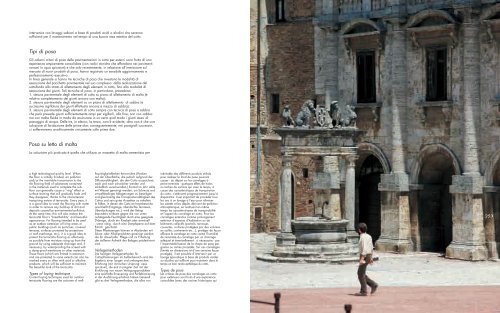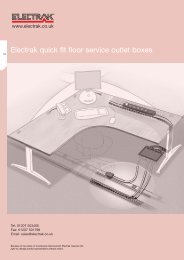by Stone & Sannini - EKA Group
by Stone & Sannini - EKA Group
by Stone & Sannini - EKA Group
Create successful ePaper yourself
Turn your PDF publications into a flip-book with our unique Google optimized e-Paper software.
intervenire con lavaggi saltuari a base di prodotti acidi o alcalini che saranno<br />
sufficienti per il mantenimento nel tempo di una buona resa estetica del cotto.<br />
Tipi di posa<br />
Gli odierni criteri di posa delle pavimentazioni in cotto per esterni sono frutto di una<br />
esperienza ampiamente consolidata (con radici storiche che affondano nei pavimenti<br />
romani in opus spicatum) e che solo recentemente, in relazione all’immissione sul<br />
mercato di nuovi prodotti di posa, hanno registrato un sensibile aggiornamento e<br />
perfezionamento esecutivo.<br />
In linea generale si hanno tre tecniche di posa che investono le modalità di<br />
esecuzione del pacchetto pavimentale nel suo complesso: dalla realizzazione del<br />
sottofondo allo strato di allettamento degli elementi in cotto, fino alla modalità di<br />
esecuzione dei giunti. Tali tecniche di posa, in particolare, prevedono:<br />
1. stesura pavimentale degli elementi di cotto su piano di allettamento di malta (e<br />
relativo completamento dei giunti ancora con malta);<br />
2. stesura pavimentale degli elementi su un piano di allettamento di sabbia (e<br />
successiva sigillatura dei giunti effettuata ancora a mezzo di sabbia);<br />
3. stesura pavimentale degli elementi di cotto sempre con tecnica di posa a sabbia<br />
che però prevede giunti sufficientemente ampi per sigillarli, alla fine, non con sabbia<br />
ma con malta fluida in modo da assicurare in un certo qual modo i giunti stessi al<br />
passaggio di acqua. Delle tre, in elenco, la terza, com’è evidente, altro non é che una<br />
soluzione di ibridazione delle prime due; conseguentemente, nei paragrafi successivi,<br />
ci soffermeremo analiticamente unicamente sulle prime due.<br />
Posa su letto di malta<br />
La soluzione più praticata è quella che utilizza un massetto di malta cementizia per<br />
a high technological quality level. When<br />
the floor is initially finished, air pollution<br />
and/or the inevitable transmission to the<br />
tile flooring field of substances contained<br />
in the materials used to complete the subfloor<br />
can generally cause a “ring” effect or<br />
surface staining that will gradually fade until<br />
they disappear, thanks to the characteristic<br />
transpiring nature of terracotta. Every year, it<br />
is a good idea to wash the flooring with water<br />
in order to remove any build-up of dirt and<br />
deposits caused <strong>by</strong> environmental pollution.<br />
At the same time, this will also restore the<br />
terracotta floor’s “breathability” and beautiful<br />
appearance. For flooring intended to be used<br />
as an outdoor extension of living areas or<br />
public buildings (such as porticoes, covered<br />
terraces, surfaces protected <strong>by</strong> projections<br />
or roof overhangs, etc.), it is a good idea to<br />
protect the terracotta flooring as effectively<br />
as possible from moisture rising up from the<br />
ground <strong>by</strong> using adequate drainage and, if<br />
necessary, <strong>by</strong> waterproofing the screed with<br />
a damp-proof membrane or other materials.<br />
These floors (which are limited in extension<br />
and are protected to some extent) can also be<br />
washed every so often with acid or alkaline<br />
products, which will be sufficient to maintain<br />
the beautiful look of the terracotta.<br />
Types of laying technique<br />
Current laying techniques used for outdoor<br />
terracotta flooring are the outcome of well-<br />
Feuchtigkeitsflecken hervorrufen (Flecken<br />
auf der Oberfläche, die jedoch aufgrund der<br />
Diffusionsfähigkeit, die den Cotto auszeichnet,<br />
nach und nach schwächer werden und<br />
schließlich verschwinden.) Einmal im Jahr sollte<br />
mit Wasser gereinigt werden, um Schmutz und<br />
umweltbedingte Ablagerungen zu beseitigen<br />
und gleichzeitig die Transpirationsfähigkeit des<br />
Cottos und sein gutes Aussehen zu erhalten.<br />
In Fällen, in denen der Cotto an Innenbereiche<br />
anschließt (Eingänge, überdachte Terrassen,<br />
Überdachungen etc.), wird der Belag<br />
besonders wirksam gegen die von unten<br />
aufsteigende Feuchtigkeit durch eine geeignete<br />
Dränage, durch ein Kiesbett oder eventuell<br />
- wenn nötig - durch eine Dampfsperre auf dem<br />
Estrich geschützt.<br />
Diese Pflasterungen können in Abständen mit<br />
Säure- oder Alkaliprodukten gereinigt werden,<br />
die für dauerhafte Pflege und zu Erhaltung<br />
der äußeren Ästhetik des Belages prädestiniert<br />
sind.<br />
Verlegemethoden<br />
Die heutigen Verlegemethoden für<br />
Cottopflasterungen im Außenbereich sind das<br />
Ergebnis einer langen und umfangreichen<br />
Erfahrung (mit römischen Ursprung: opus<br />
spicatum), die erst in jüngster Zeit mit der<br />
Einführung von neuen Verlegungsprodukten<br />
eine spürhafte Erneuerung und Perfektionierung<br />
in der Ausführung erfahren haben.Generell<br />
gibt es drei Verlegemethoden, die alles von<br />
inévitable des différents produits utilisés<br />
pour réaliser le fond de pose pourront<br />
causer - au départ sur les carrelages à<br />
peine terminés - quelques effets de halos<br />
ou taches de surface qui avec le temps, à<br />
cause des caractéristiques de transpiration<br />
du cotto, s’atténuent progressivement jusqu’à<br />
disparaître. Il est important de procéder tous<br />
les ans à un lavage à l’eau pour éliminer<br />
les saletés et les dépôts dérivant de pollution<br />
atmosphérique, en restituant en même<br />
temps les caractéristiques de transpirabilité<br />
et l’aspect du carrelage en cotto. Pour les<br />
carrelages entendus comme prolongement<br />
extérieur d’espaces d’habitation ou de<br />
bâtiments collectifs (portails, terrasses<br />
couvertes, surfaces protégées par des volumes<br />
en saillie, contrevents etc...), protéger de façon<br />
efficace le carrelage en cotto contre l’humidité<br />
de remontée du carrelage par un drainage<br />
adéquat et éventuellement - si nécessaire - par<br />
l’imperméabilisation de la chape de pose par<br />
gaines ou autres procédés. Sur ces carrelages<br />
(limités en dimensions et d’une certaine façon<br />
protégés), il est possible d’intervenir par un<br />
lavage épisodique à base de produits acides<br />
ou alcalins qui suffiront pour maintenir dans le<br />
temps un bon rendu esthétique du cotto.<br />
Types de pose<br />
Les critères de pose des carrelages en cotto<br />
pour extérieurs sont fruits d’une expérience<br />
consolidée (avec des racines historiques qui<br />
253<br />
253





